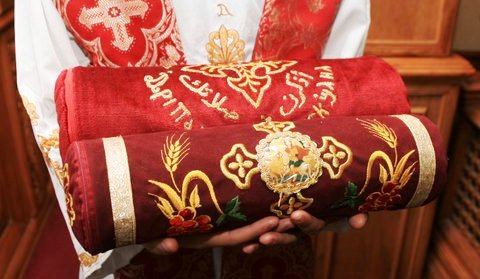Relics

Biblical Basis for having Saints Relics
The use of relics has some, although limited, basis in sacred Scripture. In 2 Kings 2:9-14, the prophet Elisha picked up the mantle of Elijah after he had been taken up to heaven in a whirlwind. With this, Elisha struck the water of the Jordan, which then parted so that he could cross. In another passage (13:20-21), some people hurriedly bury a dead man in the grave of Elisha, "but when the man came in contact with the bones of Elisha, he came back to life and rose to his feet." In the Acts of the Apostles we read, "Meanwhile, God worked extraordinary miracles at the hands of Paul. When handkerchiefs or cloths which had touched his skin were applied to the sick, their diseases were cured and evil spirits departed from them" (19:11-12). In these three passages, a reverence was given to the actual body or clothing of these very holy people who were indeed God's chosen instruments—Elijah, Elisha and St. Paul. Indeed, miracles were connected with these "relics"—not that some magical power existed in them, but just as God's work was done through the lives of these holy men, so did His work continue after their deaths. Demonstrating that it is God that works and continues to work and the power was never from the saints. Likewise, just as people were drawn closer to God through the lives of these holy men, so did they (even if through their remains) inspire others to draw closer even after their deaths. This perspective provides the Church's understanding of relics.
Early Church attitude to Relics
The veneration of relics of the saints is found in the early history of the Church. A letter written by the faithful of the Church in Smyrna in the year 156 provides an account of the death of St. Polycarp, their bishop, who was burned at the stake. The letter reads, "We took up the bones, which are more valuable than precious stones and finer than refined gold, and laid them in a suitable place, where the Lord will permit us to gather ourselves together as we are able, in gladness and joy, and celebrate the birthday of his martyrdom." Essentially, the relics—the bones and other remains of St. Polycarp—were buried and the tomb itself was the "reliquary." Other accounts attest that the faithful visited the burial places of the saints and miracles occurred. Moreover, at this time we see the development of "feast days" marking the death of the saint, the celebration of Mass at the burial place and a veneration of the remains.
After the legalization of the Church in 312, the tombs of saints were opened and the actual relics were venerated by the faithful. A bone or other bodily part was placed in a reliquary—a box, locket and later a glass case—for veneration. This practice especially grew in the Eastern Church, while the practice of touching cloth to the remains of the saint was more common in the west.
The abuse and Misuse of Relics
During the middle ages, the "translation of relics," meaning the removal of relics from the tombs, their placement in reliquaries and their dispersal, grew. Sadly, abuses grew also. With various barbarian invasions, the conquests of the Crusades, the lack of means for verifying all relics and less than reputable individuals who in their greed preyed on the ignorant and the superstitious, abuses did occur. Even St. Augustine (d. 430) denounced impostors who dressed as monks selling spurious relics of saints. Pope St. Gregory (d. 604) forbade the selling of relics and the disruption of tombs in the catacombs. Unfortunately, the popes or other religious authorities were powerless in trying to control the translation of relics or prevent forgeries. Eventually, these abuses prompted the Protestant leaders to attack the idea of relics totally. Unfortunately, the abuses and the negative reaction surrounding relics has led many people to this day to be skeptical about relics.
Our approach to Relics
Perhaps in our technological age, the whole idea of relics may seem strange. Remember, all of us treasure things that have belonged to someone we love—a piece of clothing, another personal item, a lock of hair. Those "relics" remind us of the love we share with that person while he was still living and even after death. Our hearts are torn when we think about disposing of the very personal things of a deceased loved one. In the same way the relics of saints remind us of the intense love shared between God and this saint, as holy instruments of God. The relic on earth is venerated reminding us of the true honor that God is bestowing on this Saint in heaven now.
We do not worship the actual relics, instead as St Jerome (d. 420) says in his Letter to Riparius: "We do not worship, we do not adore, for fear that we should bow down to the creature rather than to the Creator, but we venerate the relics of the martyrs in order the better to adore Him whose martyrs they are."
In all, relics remind us of the holiness of a saint and his cooperation in God's work. At the same time, relics inspire us to ask for the prayers of that saint and to beg the grace of God to live the same kind of faith-filled live.
Lives of our Church Saints
There relics can be found in the main church by the deacons area.
-
Saint Demiana
-
Martyrs of Akhmim
-
150 Men and 24 Women Martyrs from Ansena
-
St. Abaskhiroun the Soldier
-
Saint Simon the Tanner
-
St. Peter the Seal of the Martyrs
-
St. Mikhael El Beheri
-
Saint Pistavros the New


